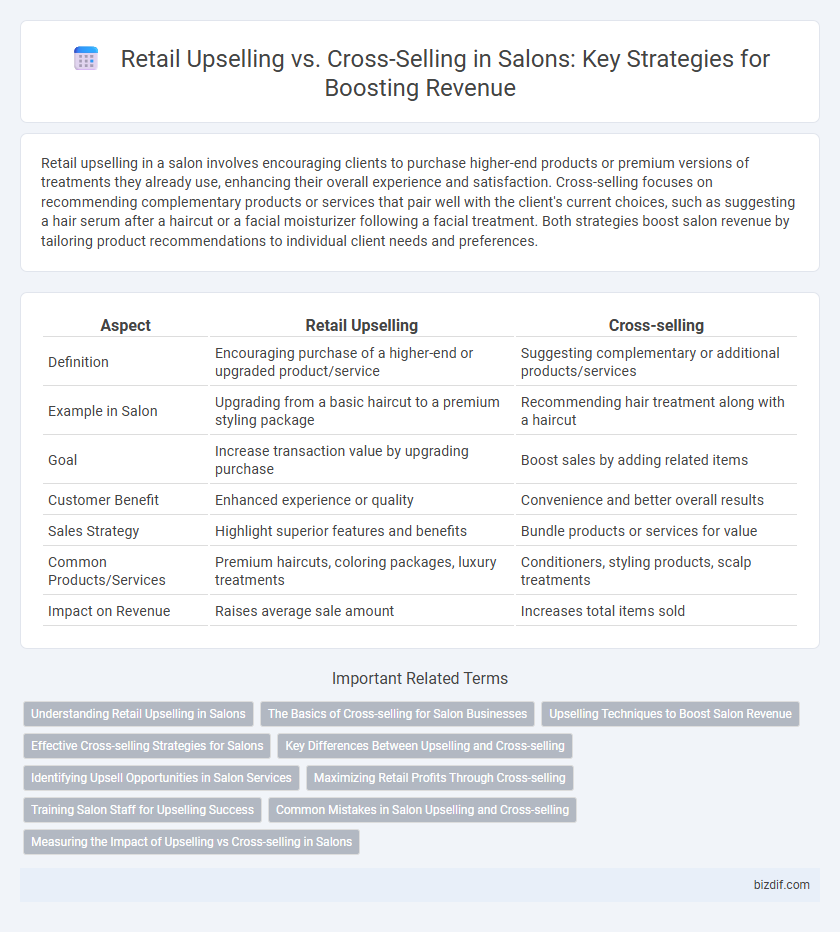Retail upselling in a salon involves encouraging clients to purchase higher-end products or premium versions of treatments they already use, enhancing their overall experience and satisfaction. Cross-selling focuses on recommending complementary products or services that pair well with the client's current choices, such as suggesting a hair serum after a haircut or a facial moisturizer following a facial treatment. Both strategies boost salon revenue by tailoring product recommendations to individual client needs and preferences.
Table of Comparison
| Aspect | Retail Upselling | Cross-selling |
|---|---|---|
| Definition | Encouraging purchase of a higher-end or upgraded product/service | Suggesting complementary or additional products/services |
| Example in Salon | Upgrading from a basic haircut to a premium styling package | Recommending hair treatment along with a haircut |
| Goal | Increase transaction value by upgrading purchase | Boost sales by adding related items |
| Customer Benefit | Enhanced experience or quality | Convenience and better overall results |
| Sales Strategy | Highlight superior features and benefits | Bundle products or services for value |
| Common Products/Services | Premium haircuts, coloring packages, luxury treatments | Conditioners, styling products, scalp treatments |
| Impact on Revenue | Raises average sale amount | Increases total items sold |
Understanding Retail Upselling in Salons
Retail upselling in salons involves encouraging clients to purchase higher-end or premium products than they initially intended, enhancing the overall customer experience while increasing revenue. By recommending salon-exclusive shampoos, conditioners, or treatments that complement the services provided, stylists boost retail sales and client satisfaction. Effective upselling requires product knowledge, personalized consultation, and aligning recommendations with clients' hair needs and preferences.
The Basics of Cross-selling for Salon Businesses
Cross-selling in salon businesses involves recommending complementary products or services that enhance the client's original purchase, such as hair treatments alongside a haircut or styling tools with color services. This strategy increases average transaction value and improves customer satisfaction by addressing broader beauty needs. Effective cross-selling requires staff training on product knowledge and personalized client consultations to identify the most relevant upsell opportunities.
Upselling Techniques to Boost Salon Revenue
Upselling techniques in salons focus on encouraging clients to choose premium services or add-ons, such as advanced hair treatments, high-end skincare products, or luxury spa packages, to increase the average transaction value. Training staff to highlight the benefits of enhanced services and personalized recommendations leverages client trust and improves customer satisfaction. Implementing strategic upselling not only boosts salon revenue but also fosters client loyalty through tailored, value-driven experiences.
Effective Cross-selling Strategies for Salons
Effective cross-selling strategies for salons include recommending complementary products that enhance clients' experience, such as suggesting a nourishing hair mask alongside a haircut or styling service. Training staff to understand client needs and preferences enables personalized product recommendations, increasing the likelihood of purchase. Implementing digital tools like appointment booking apps with integrated product suggestions further streamlines cross-selling opportunities.
Key Differences Between Upselling and Cross-selling
Upselling in a salon encourages clients to purchase a higher-end service or product than initially intended, such as upgrading a basic haircut to include a premium hair treatment. Cross-selling involves recommending complementary products or services, like suggesting a hair mask or styling product alongside a haircut. The key difference lies in upselling increasing the value of the primary purchase, while cross-selling broadens the range of products or services bought.
Identifying Upsell Opportunities in Salon Services
Identifying upsell opportunities in salon services involves analyzing client preferences and service history to recommend premium treatments, such as luxury hair masks or extended spa sessions, that enhance their experience. Leveraging stylist expertise during consultations can uncover personalized add-ons like deep conditioning or scalp massages, increasing overall revenue per visit. Integrating appointment software to track popular upgrades aids in tailoring targeted upselling strategies that resonate with individual customer needs.
Maximizing Retail Profits Through Cross-selling
Maximizing retail profits through cross-selling in salons involves recommending complementary products that enhance the client's experience, such as pairing a shampoo with a matching conditioner or styling product. Cross-selling increases the average transaction value by encouraging clients to purchase multiple related items, improving overall salon revenue. Strategic staff training on product knowledge and personalized client recommendations drives successful cross-selling efforts, boosting retail sales without overwhelming customers.
Training Salon Staff for Upselling Success
Training salon staff for upselling success involves enhancing product knowledge and communication skills to effectively recommend premium services and high-value products tailored to individual client needs. Emphasizing role-playing scenarios and personalized coaching boosts confidence in suggesting upgrades like luxury hair treatments or extended service packages. Data shows salons with targeted upselling training experience a 20-30% increase in average transaction value and improved client satisfaction.
Common Mistakes in Salon Upselling and Cross-selling
Common mistakes in salon upselling and cross-selling include pushing products or services that do not align with the client's needs, leading to dissatisfaction and loss of trust. Staff often fail to adequately understand client preferences or neglect to personalize recommendations, resulting in missed opportunities for effective sales. Overwhelming clients with too many options or aggressive sales tactics can cause discomfort and reduce the likelihood of repeat business.
Measuring the Impact of Upselling vs Cross-selling in Salons
Measuring the impact of upselling versus cross-selling in salons involves tracking key performance indicators such as average transaction value, client retention rates, and product add-on percentages. Upselling typically increases revenue by encouraging clients to choose premium services, while cross-selling boosts sales through complementary product recommendations. Analyzing sales data and customer feedback helps salons optimize their marketing strategies and maximize profitability.
Retail Upselling vs Cross-selling Infographic

 bizdif.com
bizdif.com